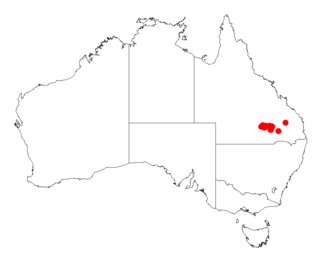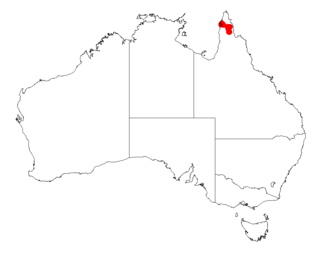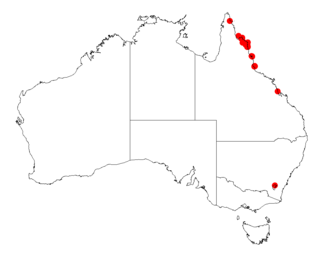
Acacia podalyriifolia is a perennial tree which is fast-growing and widely cultivated. It is native to Australia but is also naturalised in Malaysia, Africa, India and South America. Its uses include environmental management and it is also used as an ornamental tree. It is very closely related to Acacia uncifera. It grows to about 5 m in height and about the same in total width. It blooms during winter.

Acacia decora is a plant native to eastern Australia. Common names include the western silver wattle and the showy wattle. The species name refers to the plant's decorative qualities.

Acacia concurrens, commonly known as curracabah or black wattle, is a shrub native to Queensland in eastern Australia.

Acacia brachycarpa is a shrub belonging to the genus Acacia and the subgenus Phyllodineae endemic to Queensland.

Acacia calantha is a shrub belonging to the genus Acacia and the subgenus Phyllodineae native to Queensland in Australia.
Acacia arbiana is a species of wattle that is endemic to Queensland.

Acacia johnsonii, commonly known as gereera wattle or geereva wattle, is a shrub belonging to the genus Acacia and the subgenus Phyllodineae that is native to parts of eastern Australia.

Acacia saxicola, commonly known as Mount Maroon wattle, is a shrub belonging to the genus Acacia and the subgenus Phyllodineae native to eastern Australia.

Acacia tenuinervis is a shrub or tree belonging to the genus Acacia and the subgenus Juliflorae that is native to north eastern Australia.
Acacia argyrotricha is a shrub of the genus Acacia and the subgenus Plurinerves that is endemic to north eastern Australia

Acacia homaloclada, also commonly known as Hitchinbrook wattle, is a shrub of the genus Acacia and the subgenus Plurinerves that is endemic to north eastern Australia. It is listed as vulnerable according to the 1992 Nature Conservation Act.

Acacia hylonoma, commonly known as Yarrabah wattle,is a shrub of the genus Acacia and the subgenus Plurinerves that is endemic to a small area of the north eastern Australia.

Acacia johannis is a shrub of the genus Acacia and the subgenus Plurinerves that is endemic to a small area of north eastern Australia.

Acacia legnota, also known as heath wattle, is a shrub of the genus Acacia and the subgenus Plurinerves that is endemic to an area of north eastern Australia.

Acacia leptoloba, also known as Irvinebank wattle, is a shrub of the genus Acacia and the subgenus Plurinerves that is endemic to an area of north eastern Australia.

Acacia maranoensis, commonly known as womel, is a shrub of the genus Acacia and the subgenus Plurinerves that is endemic to an area in north eastern Australia.

Acacia microcybe is a shrub of the genus Acacia and the subgenus Plurinerves that is endemic to an area of north eastern Australia where it is listed as being of Least Concern according to the Nature Conservation Act 1992.

Acacia microsperma, commonly known as bowyakka, is a shrub of the genus Acacia and the subgenus Plurinerves that is endemic to an area of eastern Australia]. It is rated as least concern according to the Nature Conservation Act 1992.

Acacia ommatosperma is a shrub of the genus Acacia and the subgenus Plurinerves that is endemic to an area of north western Australia.

Acacia racospermoides is a shrub or tree of the genus Acacia and the subgenus Plurinerves that is endemic to an area of north western Australia.

















